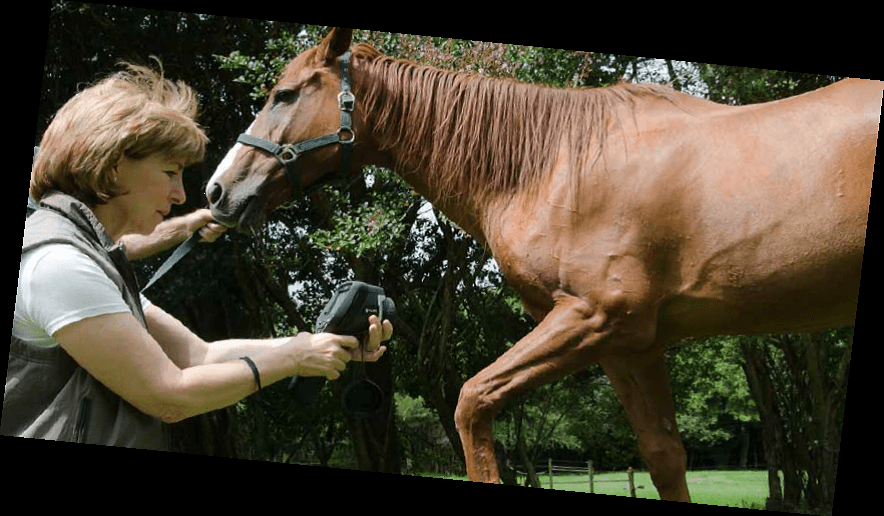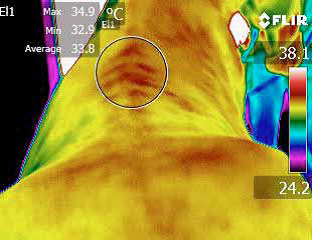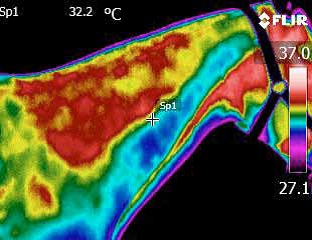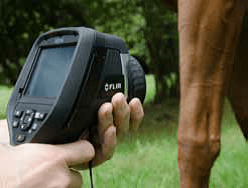Equine Clinic Enhanced With Thermal Imaging Camera

Thermal imaging cameras are increasingly being used as important diagnostic tools in equine medicine, with the technology proving its worth time and time again as an early warning system for health issues in horses.
Thermography can be used to find the site of an infection, uncover soft tissue damage and other health problems and with the benefit of early detection, treatment regimes can begin immediately, expediting recovery and preventing further serious injury.
Historically, those working with horses and veterinarians have used their hands to ‘feel’ the animals for any temperature changes that could indicate an infection or other problem. Like human skin, horse skin feels hot to the touch if there is an underlying problem such as a muscle strain or infection, but because people can only feel changes in temperature that are over 20C, the human touch has limitations. On the other hand, a modern thermal imaging camera can detect a temperature change of less than 0.030C.
 |
| This thermal image shows a thermal pattern typical for the condition known as kissing spine. |
It was this diagnostic potential that led an equine clinic owner to research the technology in more detail.
Through her research, she quickly realised that the technology not only played a very useful diagnostic role, it also had the potential to help with ‘referred pain’. She had encountered numerous situations where the horse’s injury wasn’t in the place where the owner had originally thought it was, but was actually in a different area of the animal’s body. This ‘referred pain’ occurs when the injury forces the horse to compensate its stance to alleviate the pain or discomfort of the injury and if left untreated, can escalate into a serious problem. She realised that the increased heat of these hidden injuries could be detected by thermography and that a thermal imaging camera would be a valuable additional tool in helping evaluate that type of injury.
 |
| This thermal image shows referred pain in the neck area as a result of an abcess in the front hoof. |
The clinic owner’s research also enlightened her about the surprising affordability of the cameras.
As technology had advanced over the years, products had come to market that were cheaper, easy to use and which delivered high quality results – all of which convinced her that her business would benefit substantially from having its own thermal imaging camera.
She opted for the FLIR E60bx thermal imaging camera which she says gives her crisp, well-focused images and which gives accurate thermal readings over small temperature changes. Just like a regular digital camera, the more pixels the thermal camera has, the clearer, sharper and more detailed the image will be. WiFi connectivity also enables the vet to produce reports, virtually in real-time so that treatment can be expedited and problems solved sooner.
As she notes however, successful equine thermography depends on more than just a good camera. A thorough knowledge of the animals’ physiology and anatomy is vital and she believes that her decades of experience working with horses makes an enormous difference to the accuracy with which she interprets the radiometric images. She cited the situation where human hands could touch the horse’s skin and create a false reading – a possibility that an experienced eye would consider but which may be missed by someone new to the technology.
Technical support is invaluable when it comes to using inspection technologies such as thermography and the equipment supplier can play an important role in ensuring that the instruments meet expectations and deliver meaningful results. In the case of the clinic owner, support from her local agent has been crucial and has helped her provide reliable thermal imaging services to a wide range of clients.
The demand for equine thermal imagery comes from all corners of the equestrian industry including breeding, racing, horse trails, polo players, show jumpers, carriage horses and endurance drivers to farriers and equine physiotherapists – all of whom want the very best in health services for their animals. Thermal imaging enables early detection of problems and early intervention with the appropriate treatment regimes – saving horse owners time and money and reducing the likelihood of their animals suffering unnecessarily.
If you’d like to learn more about thermal imaging cameras, the experts at Nexxis can help. We are Australia’s leading technical equipment specialists and offer a wide range of high quality FLIR cameras to buy or rent. Depending on your situation, we will tailor-make a practical, affordable solution for you that will meet your changing needs plus we have years of industry experience so they understand all the ins and outs of this highly specialised technology. Have a look at our range of infrared thermal imaging cameras or speak to one of our industry professionals by contacting us.

